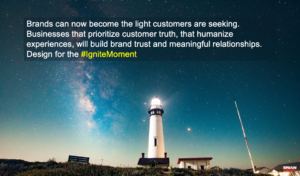
The future of TV is much more than social, it’s a multi-screen experience that takes design. Often, producers, broadcast and movie marketers and brands alike underestimate the role social media plays as consumers watch, share, and interact. Whether its watching movies, TV shows or listening to music, consumers will have at least one-to-two other devices in grasp or within reach. Depending on the device, each screen is used differently and with purpose. As a result, each screen requires the thoughtful development of an engaging or entertaining experience.
This is a topic that I have and will continue to explore. I believe the entertainment industry is uniquely positioned to introduce a connected, cross-platform experience layer that captivates and grows audiences while creating new opportunities for monetization.
In addition to sharing my thoughts, I will also feature the work of others who are experimenting beyond what we think we know to learn and share just what’s possible. I invited Gayle Weiswasser VP, Social Media Discovery Communications, to stop by for an in-depth interview. Here, she shares how her team is building a new infrastructure to unite programming, audiences, and talent to change how Discovery creates, markets, and supports new experiences.

What is the prevailing mission and purpose for Discovery’s social media strategy?
At Discovery, social media represents an individual, intimate touchpoint with our audiences. Our social accounts allow us to interact with fans in a manner that was previously impossible for large broadcasters: two-way, real-time conversation around our programming and talent. Our mission is to augment our fans’ experience with our networks through relevant content, access to talent, exclusives and other interactions that celebrate our fans and shine a spotlight on their passions.
We use social media primarily for four purposes: 1) engaging with fans and encouraging that two-way conversation; 2) driving tune-in to our programming; 3) driving traffic to our owned-and-operated fansites; and 4) gathering insights about fan preferences and reactions that we can share internally with our network marketing, communications and production partners.
What is the current size of the communities you manage and what has overall growth and size of your social media footprint evolved?
As of April 2012, we have 59 million likes across approximately 75 active Facebook pages; on Twitter, we have 3.5 million followers across 21 accounts. Our Facebook footprint grows by about two million likes a month, and in 2011, our fan counts on both platforms doubled. That growth has come almost entirely organically, with very few targeted spends or buys aimed at building our social audience.

How does strategy come to life in the organization?
Social media strategy is developed by a centralized team that works in lockstep with our communications, marketing, digital media and many other teams. It is truly a joint, multi-disciplinary effort. Our social media team works hard to ensure that each of our plans is executed in line with the other teams’ strategies, and we engage in early cross-functional brainstorming and strategy meetings to ensure that we are maximizing the potential of social media to support network initiatives.
On average how many social media presences does Discovery host at any one time?
We currently have 75 active Facebook pages and 21 Twitter accounts (U.S. network and show-related), and also have several network Pinterest accounts. We’ve also done some experimentation on Tumblr and Google+, and work with several social TV players, like GetGlue, Miso and Viggle.
How do you distribute presences, for example, which shows get Facebook pages vs. Google + vs. Twitter vs. YouTube, etc.
For now, we’re focusing on where our largest and most engaged audiences are: Facebook, Twitter and Pinterest. Every network has a Facebook and Twitter account, and most of our popular programs have their own Facebook pages as well. We have a set of factors that we balance before launching a new social media account – everything from whether the show has been greenlit for more than one season to how much related content we will have to share with fans year-round. Given our large social footprint, we are often able to support new series through network pages and cross promotion, which may give way to a new Facebook page as the audience builds.
What are some of the prime metrics that you use to define success?
Engagement metrics are the ones we focus on the most: are people reacting to, and being inspired by, our content? Are they liking, commenting, clicking, and sharing? Those are the numbers we’re most focused on, as they tell us whether we’re doing a good job of building that important relationship with our audiences. The footprint number is meaningless if we’re not actually connecting with those fans.
Are you using social media to drive tune-in and what are your observations on what’s possible here?
Yes, that’s one of our main goals for social media. We have a lot of anecdotal evidence that our social media activity – particularly real-time activity around premieres – drives buzz and, in turn, increases the likelihood that existing and new viewers will tune in. And, of course, we follow the social TV studies that have been published lately, such as Nielsen’s conclusion that pre-show social activity drives ratings increases and TVGuide.com’s report that people are watching more live TV to avoid spoilers. We think that there is a world of possibility here – with at least 40-45% of people using smart devices/laptops while they are watching TV. This year, we will be doing more with live, on-air streaming of social integrations, which we expect will only strengthen the social media-tune-in connection.
How have you organized around social media to manage an extensive and engaged network?
We have a centralized social media team that acts as an in-house social media agency, with the networks as our clients. Within the team, we have members dedicated to each network, and they attend all of the network meetings that touch social media (marketing/communications/digital/production) so that they are entirely engaged in all of the network plans. The centralized structure allows the team to share best practices, do cross-network promotions, test emerging platforms, and develop social media guidelines that extend across networks.
Any special practices for internal coordination?
– Social CMS?
– Style Guide?
– Best practices?
– Training?
These types of practices are done within our centralized team, which is another benefit to the structure. We have a social media style guide, and we meet three times a week as a team to brainstorm and develop best practices.
How do you decide when it’s time to retire an account?
We retire accounts when we no longer have regular, relevant content to share with their audiences. This may happen when a show finishes its run, although we have several active social communities that are still going strong even though the shows they were built around are no longer in premieres. If we can’t provide the community with good content, then we will shut down the account, after ensuring that fans have notice and the opportunity to join similar social communities we manage, if available.
Any final advice, tips, or cautionary tales to leave us with as we put your experiences into action?
Don’t underfund or understaff your social media teams – the purpose they serve is too important to give it short shrift. And be sure that your team isn’t silo-ed. The key to an effective social media strategy is integrating social across your business by keeping the lines of communication open.
Follow Gayle on Twitter.
__
Connect with Brian: Twitter | LinkedIn | Facebook | Google+
The End of Business as Usual is officially here…
TV Image Credit: Shutterstock






Having a team solely dedicated to the task of social has got to be a cream dream. The solo entrepreneur who has to wear every single hat – sales, marketing, accountant, content creator, social media master, etc. – is at a huge disadvantage when it comes to leveraging social for maximum impact. If the corporations ever nail down the formula and get their teams stalking the whole world wide web, and they figure out how to bond, the little guy is in for a battle on this front. I’m very much looking forward to it. 🙂
Mike, Indeed it is. It’s also an amazing time for developers. Would love to talk. I’ll also take a look at the book. Cheers!
Great tips and certainly social media is all about making communication directly with your website readers and answering their queries on time certainly builds an authority and trust, that’s helps your business to grow.
Thanks for sharing great tips!
Mike – I saw this book on Amazon and added it to my wishlist. The TV experience is definitely changing as many television content creators are using social as a platform for backchannel conversations.
I like what State Farm did with Nascar. They added a Twitter hashtag on the car they sponsor in order to allow the fans of that driver to find each other on Twitter. State Farm brought the fans together to make the races more exciting.
Hey Nathan, I think that was Farmers! 🙂
Discovery is has an awesome advantage though. They have a multitude of great programming that have their own pages as well but to take the fan base of several great programs and pool them is a great milestone to get. Besides, who doesn’t love Deadliest Catch. Those guys are crazy.
I think that it is vital to the success of a company’s social media attempts to do more than just make an account and gain followers. Companies like Discovery are very smart in the way in which they engage fans and use their social media platforms to create revenue, or in this case viewers. I am excited to see where social media takes us in the next 5, 10, 15 years!
Gayle has done a great job with Discovery. The world is constantly evolving and new technology is emerging every day. Social media is not a technology of the future. It is today’s technology! Society literally has access to nearly everything in the palm of their hand. Therefore, it would be remiss if a professional, company or organization did not utilize this technology to their advantage. Gayle is smart to invest in her social media department!
Awfully insightful.
cross-platform experience layer that captivates and grows audiences while creating new opportunities for monetization.